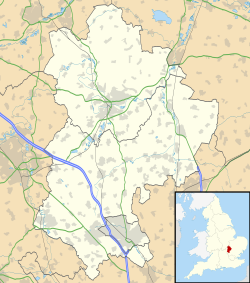Village history
Shortstown was built on Tinker's Hill, Harrowden. Before it was built, a windmill stood on the site from 13th to 16th century. From 17th to 18th century, the area was known as Windmill Hill. [3] Shortstown started with the establishment of the Airship Works in 1917 when housing for the workforce was built next to the airfield. In 1918 and 1927, sheds (later Grade II* listed buildings) were built for the R100 and R101 airships which then represented the latest passenger flight technology. The village was originally built by the Short Brothers for its workers, [4] but evolved into a settlement for people working at the RAF Cardington base.
A map from 1915 of an area where Shortstown now stands.
[5] A map from 1946 of an area where Shortstown now stands.
[6]
Shortstown was only created from 1916 onwards. The land originally lay in the township of Eastcotts which was itself a part of the ancient parish of Cardington. Eastcotts became a separate civil parish in 1866. [7]
The site selected for the Short Brothers airship works was broad, level and unobstructed. It had good road and rail links with London and was beyond the range of World War I German bombers based in Belgium.
In October 1916, the site was acquired by the Admiralty from the Whitbread Estate for £110,000. Short Brothers planned to build housing for 600 employees in a new settlement near to the works. By June 1919, one hundred and fifty one homes in a "simplified neo-Georgian style", mostly of red brick with dark red tile roofs had been constructed. Architects were Robert Burns Dick and James Cackett of Newcastle upon Tyne. The houses were arranged in groups of terraces and a social club was built. [3]
Short Brothers vacated the Cardington site on 1 April 1919 and it was taken over by the government and renamed the Royal Airship Works. [3]
Shorts Building
The Shorts Building was built in 1917. It has taken on many guises, ranging from an Administration Block in the early airship days to Station HQ in WW2 and, in more recent years, as a training centre for the Civil Service. However, despite its many uses, it is still referred to today as The Shorts Building and now, over 90 years later, has been restored to its former glory as part of the new Bellway development. [8]
Cardington airship sheds, former
Short Brothers works housing
R100 and
R101 airships. Shed no.1 (left) now holds the new aircraft
Airlander 10. Shed no.2 (right) is used for creating films that require a large open-space area
The Shorts Building before it was refurbished in 2011
The Shorts Building fully refurbished
The back of the refurbished Shorts Building
The building was refurbished in 2011, and a new site called New Cardington was also built. It is now used for 20 residential apartments and has a Public Common Hall, that shows a permanent display of 17 enhanced historic R101 photographs taken from The Airship Heritage Trust collection. There are also additional community rooms and Eastcotts Children's Centre is based here too. [8]
RAF Cardington
The Royal Airship Works was put on a care and maintenance basis until 1938, when it was renamed the Balloon Development Establishment. However, the social club at Shortstown was still known as the Royal Airship Works and Shortstown Club in the 1980s.
In the meantime, in 1936, an RAF station had opened at Cardington, being particularly concerned with producing gas for barrage balloons and training barrage balloon crews as well as more general training of recruits and NCOs. Throughout the 1940s, Cardington remained a busy RAF station, and from 1953, it became the RAF's main recruitment centre.
After the Second World War, further houses were built at Shortstown as married quarters for RAF personnel. The three avenues off the southern extension of Greycote are named after three prominent victims of the R101 disaster: Brigadier-General Lord Thomson, Secretary of State for Air; Air Vice Marshal Sir W. Sefton Brancker, Director of Civil Aviation at the Air Ministry and Major George Herbert Scott, Assistant Director of Airship Development (Flying and Training) at the Royal Airship Works.
The roads of the western half of the site are all named after Second World War bomber aircraft.
With the ending of National service and cuts in the armed forces the RAF's presence at Cardington began to dwindle and largely disappeared in the 1970s. As a result, the population of Eastcotts declined from 3,675 in 1951 to 1,710 in 1981.
Shortstown today
Since 2012, there has been significant housing development on land to the east of the A600, [9] this part of the village is marketed as New Cardington and Eastcotts Green to appeal as more upmarket than Shortstown. Over half of the homes on New Cardington development are for Housing Associations. A new school and shops have been built in the centre of Shortstown. Although Bellway Homes marketed the development as New Cardington, in fact, it remains an extension of Shortstown.
In May 2017, Shortstown celebrated its centenary with Shortstown Fun Day in June, a firework display in September and a Centenary Reunion in November. [10]
In April 2019 Shortstown became a civil parish, having previously been part of the parish of Eastcotts. [11] [12]
This page is based on this
Wikipedia article Text is available under the
CC BY-SA 4.0 license; additional terms may apply.
Images, videos and audio are available under their respective licenses.









